Wednesday, January 28, 2009
Mouse lemur in action!
Monday, October 13, 2008
Back to the grindstone....
 Prepared October 13, 2008
Prepared October 13, 2008Well, I made it back to the
Thanks to anyone who kept up with my activities this summer—I really appreciate your interest! I’ll be heading back to  That means Indri, so if you’re interested in their teddy-bear looks and unique,
That means Indri, so if you’re interested in their teddy-bear looks and unique,
Cheers,
Meredith
A little time for exploring…..

Prepared September 17, 2008
Secret of our success

Taste the rainbow....a food montage
As food structures the day around here, I thought I would share with you what a typical day in the life of food at Kirindy Mitea is like.
Breakfast, 
Lunch, 

It’s hard to forget. I’ve found that with ample amounts of garlic powder, parmesan cheese and
Friday, October 3, 2008
Microcebus Super-Sleuths
Prepared
It seems as though there are new Microcebus species popping up every week….what once had been defined as an eastern and a western species now has been amended to include several species. This has caused some ongoing controversy as scientists debate which species should be considered separate and which should not. But the DNA will tell the tale—that’s why we’re sure to collect small samples of skin to use for genetic analyses. In addition to this data, we’re also noting all the variations in color and size that we see in the mouse lemurs. Armed with this combination of information, we hope to figure out the complex mystery that is mouse lemur speciation in
Wednesday, October 1, 2008
Boom & Bust
 I don’t know if field work attracts gambling personalities, but it sure seems like that would be helpful to deal with the constant unknown of capture—so much is out of your control. It’s like I buy a Keno ticket every night when we put out our traps, and sometimes our numbers come up. That’s just one of things that keeps life interesting around here. If only I could make money doing this! Just to give you an example of how unpredictable capture can be—in one week we had a few days in a row of no mouse lemurs captured—0 (see my disappointment in the photo to the right). Then the next day we were overrun with mouse lemurs, capturing 10 in one of the grids (see jubilation below). I think they just like to keep us guessing.
I don’t know if field work attracts gambling personalities, but it sure seems like that would be helpful to deal with the constant unknown of capture—so much is out of your control. It’s like I buy a Keno ticket every night when we put out our traps, and sometimes our numbers come up. That’s just one of things that keeps life interesting around here. If only I could make money doing this! Just to give you an example of how unpredictable capture can be—in one week we had a few days in a row of no mouse lemurs captured—0 (see my disappointment in the photo to the right). Then the next day we were overrun with mouse lemurs, capturing 10 in one of the grids (see jubilation below). I think they just like to keep us guessing.
Tuesday, September 30, 2008
Kirindy Mitea turns 10 and has a growth spurt
To counteract the gloomy message of the last entry, I’m going to share with you some great  news. Within the last year, the Malagasy government and its park management agency, Association Nationale pour la Gestion des Aires Protégées (ANGAP), decided to expand the size of
news. Within the last year, the Malagasy government and its park management agency, Association Nationale pour la Gestion des Aires Protégées (ANGAP), decided to expand the size of
Sunday, September 28, 2008
Cows and dogs and rats, oh my!
Mouse lemurs aren’t the only animals that I’m concerned about out here. Expanding human populations, which push the boundary into preserved areas for resource extraction, hunting, subsistence agriculture and cattle grazing, could lead to potentially huge impacts on the conservation and health of wildlife populations. Where humans go, their domesticated animals typically follow, and where domestic animals go, their parasites are sure to tag along. We can simply look to human history to see the implications of animal domestication. One of the major transitions in lifestyle occurred about 10,000 years ago as agriculture developed. By producing our own food and domesticating animals, humans were able to rapidly increase their populations, and began to live in denser aggregations like towns and cities.  This increased density, along with the mixing of multiple species (humans and livestock) in a small area lead to an upsurgence of disease. Over 600 known parasites occur in domesticated animals, and over 60% of the over1400 parasites found in humans have come from a domestic animal origin. To make matters worse, all of these densely packed people and livestock attract another player into this equation—rodents. And as we all have learned from the 14th century’s Black Death, rodents are exceptional couriers of disease. Unfortunately, all of these issues are important to consider for conservation in
This increased density, along with the mixing of multiple species (humans and livestock) in a small area lead to an upsurgence of disease. Over 600 known parasites occur in domesticated animals, and over 60% of the over1400 parasites found in humans have come from a domestic animal origin. To make matters worse, all of these densely packed people and livestock attract another player into this equation—rodents. And as we all have learned from the 14th century’s Black Death, rodents are exceptional couriers of disease. Unfortunately, all of these issues are important to consider for conservation in  Villages on the edge of reserves raise and graze their cattle through preserved areas, their dogs and cats wander through, and even humans leave their waste in the reserves. Additionally, the black rat (Rattus rattus) has expanded to cover the entire island since its accidental introduction in
Villages on the edge of reserves raise and graze their cattle through preserved areas, their dogs and cats wander through, and even humans leave their waste in the reserves. Additionally, the black rat (Rattus rattus) has expanded to cover the entire island since its accidental introduction in
Friday, September 26, 2008
Lepilemurs sneak into my dreams at night. It’s not hard, what with their loud, Iwok-sounding calls back and forth filling the forest night air. These nocturnal “sportive” lemurs are a delight to experience. As I brush my teeth, I shine my headlamp through the tops of the trees, looking for their distinctive marble-sized eyes staring back at me. They rest in hollows of trees during the day, saving up their energy to generate an auditory spectacle at night.  I have other visitors at night as well—the legendary and elusive Fossa (Cryptoprocta ferox) comes by my tent at night every few days. A pair of them roams the camp looking for water and goodies, and they also have an insatiable curiosity. They will paw through my campsite at night, poking my tent just to figure out what it is. I sit bolt upright in my sleeping bag, thinking about the sheer millimeter of tent material that separates me from Madagascar’s largest carnivore…..But when my headlamp comes on and I give the tent a shake, the fossas are out of there. Or at least that’s what I keep hoping. Keeps you on your toes.
I have other visitors at night as well—the legendary and elusive Fossa (Cryptoprocta ferox) comes by my tent at night every few days. A pair of them roams the camp looking for water and goodies, and they also have an insatiable curiosity. They will paw through my campsite at night, poking my tent just to figure out what it is. I sit bolt upright in my sleeping bag, thinking about the sheer millimeter of tent material that separates me from Madagascar’s largest carnivore…..But when my headlamp comes on and I give the tent a shake, the fossas are out of there. Or at least that’s what I keep hoping. Keeps you on your toes.
And an update: Well, the fossa did not stay quite so docile this time. Apparently he likes my shoes, or my feet smell like lemurs, because he chewed some nice chunks out of my sandals. A good souvenier story, right?
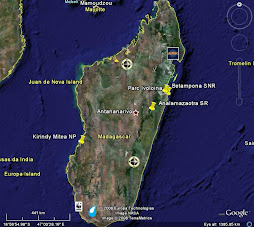
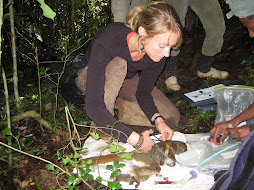.jpg)
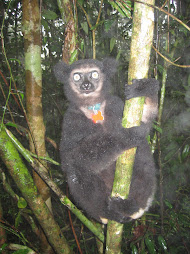.jpg)
.jpg)
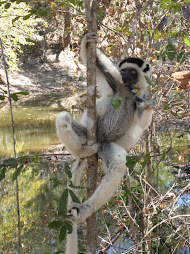.jpg)
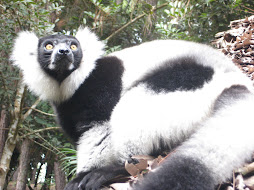.jpg)